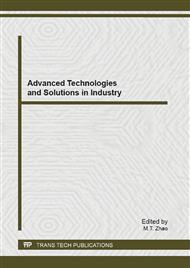p.127
p.132
p.136
p.142
p.147
p.152
p.157
p.161
p.166
Study on the Optimum Hot-Pressing Process and Surface Decoration of Waste Tetra Pak/Sawdust Composite Board
Abstract:
To improve the way of efficient recycling of waste Tetra Pak package, save wood materials and develope new packaging materials, this article studied on the optimum hot-pressing process and surface decoration of waste Tetra Pak/sawdust composite board. Using the orthogonal experimental method, we studied the effect of that four factors, such as resin content, hot-pressing temperature, hot-pressing time and Tetra Pak/sawdust mass ratio, on MOR, MOE, TS for 2h of waste Tetra Pak/sawdust composite board. And according to the measurement and analysis of these three test indicators of the board, we obtained the optimum hot-pressing process of waste Tetra Pak/sawdust composite board. The results showed the optimization of process parameters for the board was that: resin content for 14%, hot-pressing temperature for 150°C, hot-pressing time for 420s and Tetra Pak/sawdust mass ratio for 4:6 were suitable to product this board. At this point, the maximum MOR of the board was up to 23.1MPa, the maximum MOE of the board was up to 2917MPa, the minimum TS for 2h of the board was down to 6.1%. In the processing of PVC surface decoration, by using comparison tests, the results figured out that hot-pressing temperature for 50°C-60°C, hot-pressing time for 10s-20s, hot-pressing pressure beyond 0.02MPa were good for PVC to decorate this kind of board. The formaldehyde emission of this veneer composite board was 0.3mg/L, the surface abrasion resistance of it could reach 900r, besides, its performance of surface pollution resistance has reached the national standard.
Info:
Periodical:
Pages:
147-151
Citation:
Online since:
June 2013
Authors:
Price:
Сopyright:
© 2013 Trans Tech Publications Ltd. All Rights Reserved
Share:
Citation:


